1995 Oldsmobile Cutlass Supreme ESP
[x] Cancel search: ESPPage 19 of 340
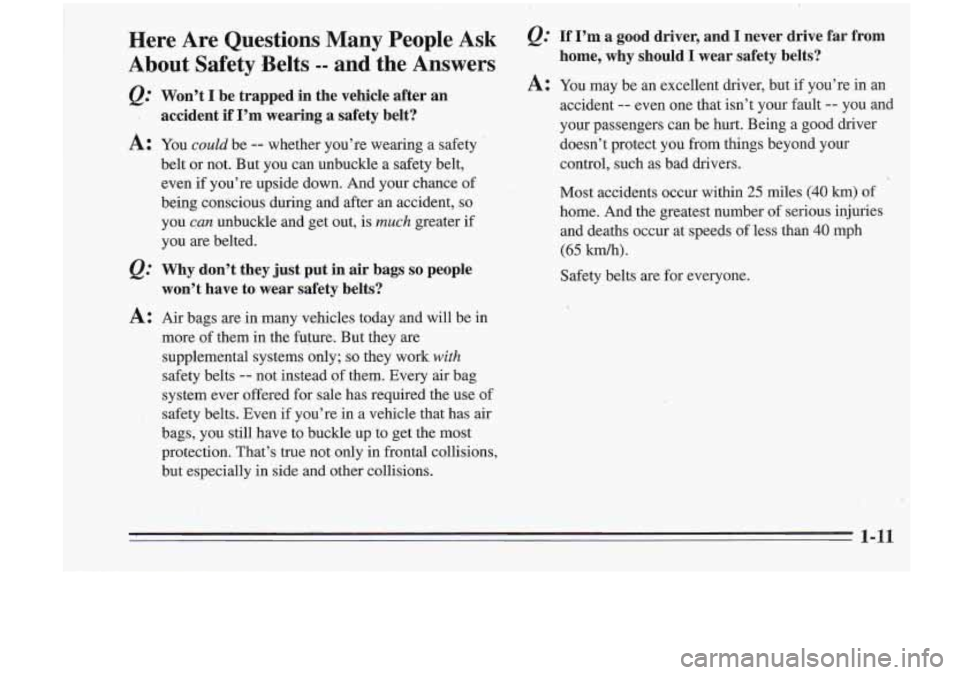
Here Are Questions Many People Ask
About Safety Belts
-- and the Answers
&: Won’t I be trapped in the vehicle after an
accident if
I’m wearing a safety belt?
A: You could be, -- whether you’re wearing a safety 1
belt or not. But you can unbuckle a safety belt,
even if you’re upside down. And your chance of
being conscious during and after
an accident, so
you can unbuckle and get out, is much greater if
you are belted.
&.’ Why don’t they just put in air bags so people
won’t have to wear safety belts?
A: Air bags are in many vehicles today and will be in
more of them in the future. But they are
supplemental’systems only;
so they work with
,safety belts -- not instead of them. Every air bag
system ever offered for sale has required the use of
safety belts. Even if you’re in a vehicle that has air
bags, you still have to buckle up to get the most
protection. That’s true not only in frontal collisions,
but especially in side and other collisions.
@ If I’m, a good driver, and I never drive far from
A: You may be an excellent driver, but if you’re in an
home, why should I wear safety belts?
accident -- even one that isn’t your fault -- you and
your passengers can be
hurt. Being a good driver , I
doesn’t protect you from things beyond. your
control, such as bad drivers. I
Most accidents occur within 25 miles (40 km) of
home. And the greatest number of serious injuries
and deaths occur .at speeds of less than
40 mph
(65 km/fi).
Safety belts are for everyone.
1-11
Page 67 of 340
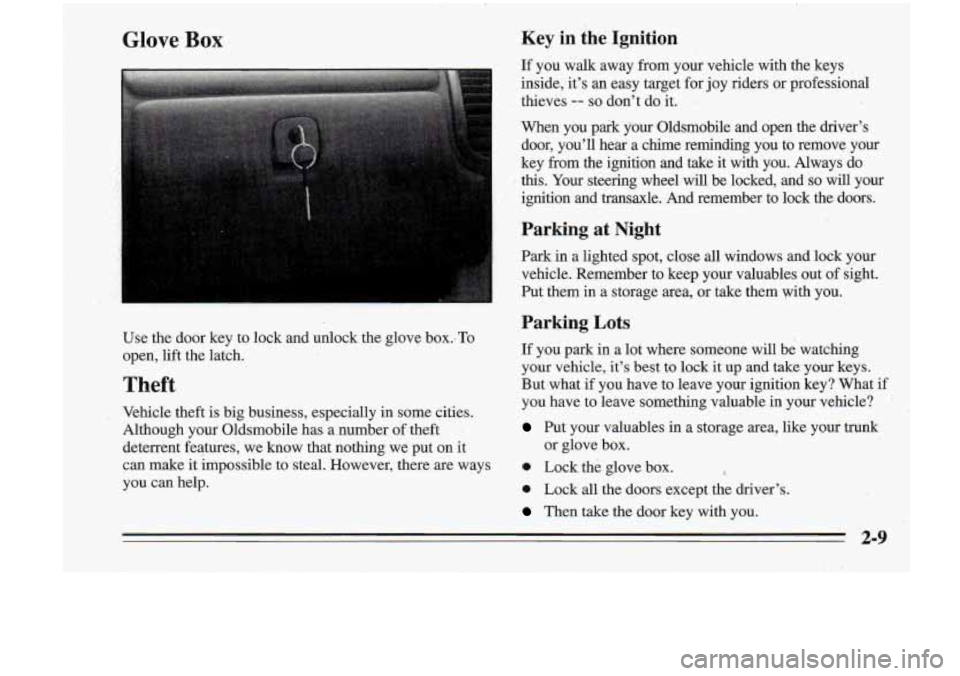
Glove Box Key in the Ignition
If you walk away from your vehicle with the keys
inside, it’s an easy target
€or joy riders or professional
thieves
-- so don’t do it.
When you paik your Oldsmobile and open the driver’s
door, you’ll hear a chime reminding you to remove your
key from the ignition and take it with you. Always do
this. Your steering wheel will be locked, and
so will your
igmtion and transaxle.
And remember to lock the doors.
Parking at Night
Park in a lighted spot, close all windows and lock your
vehicle. Remember to keep your valuables out
of sight.
Put them in a storage
area, or take them with you.
Use the door key
to lock and unlock the glove box..To
open, lift the latch.
Theft
.. Vehicle theft is big business, especially in some cities.
Although your Oldsmobile has a number of theft
deterrent features, we know that nothing we put on it
can make it &possible to steal. However, there are ways
Parking Lots
If you park in a lot where someone will be watching
your vehicle, it’s best to lock it up
and take your keys.
But-what
if you have to leave your ignition key? What if
you have to leave something valuable in your vehicle? ’
Put your valuables in a storage area, like your trunk
0 Lock the glove box.
or
glove box.
you can help.
0 Lock all the doors except the driver’s.
Then take the door key with you.
2-9
Page 90 of 340
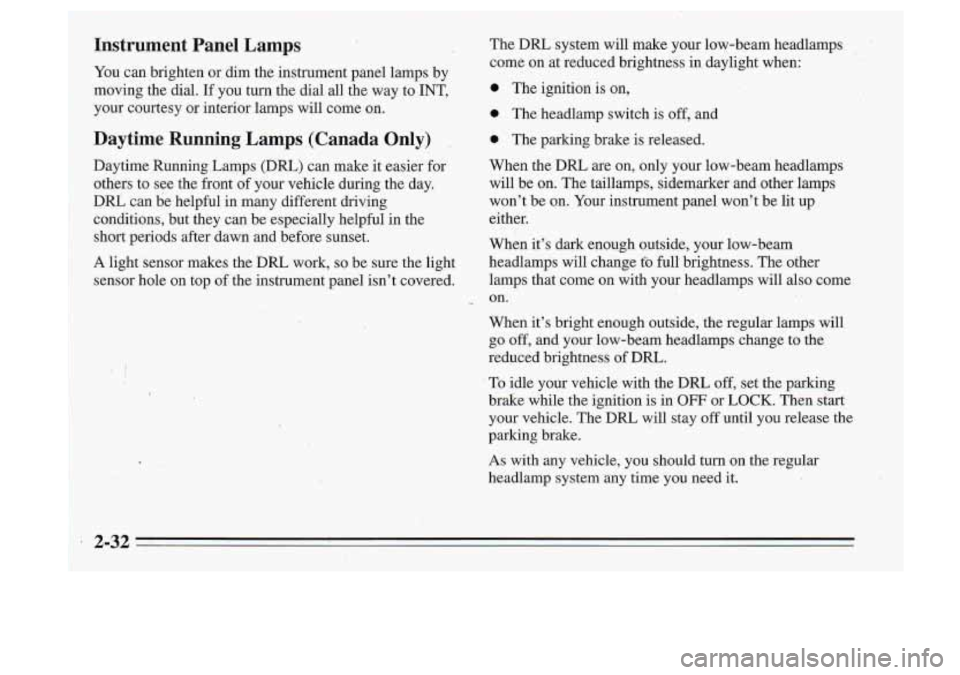
Instrument Panel Lamps
You can brighten or dim the instrument panel lamps by
moving the dial. If you turn the dial all the way to INT,
your courtesy or interior lamps will come on.
Daytime Running Lamps (Canada Only)
Daytime Running Lamps (DRL) can make it easier for
others to see the front of your vehicle during the day.
DRL can be helpful in many different driving
conditions, but they can be especially helpful in the
short periods after dawn and before sunset.
A light sensor makes the DRL work, so be sure the light
sensor hole on top
of the instrument panel isn't covered. The
DRL system will make your low-beam headlamps
come on
at reduced brightness in daylight when:
0 The ignition is on,
0 The headlamp switch is off, and
0 The parking brake is released.
When the
DRL are on, only your low-beam headlamps
will be on. The taillamps, sidemarker and,other lamps
won't
be on. Your instrument panel won't be lit up
either.
When it's dark enough outside, your low-beam
headlamps will change
fo full brightness. The other
lamps that come on with your headlamps will also come
on.
When it's bright enough outside, the regular lamps will
.go
off, and your low-beam headlamps change to the
reduced brightness of
DRL.
; To idle your vehicle with the DRL off, set the parking
brake while the ignition is in
OFF or LOCK. Then start
your vehicle. The
DRL will stay off until you release the
parking brake.
As with any vehicle, you should turn on the regular
headlamp system any time you need it.
. 3 13
Page 133 of 340
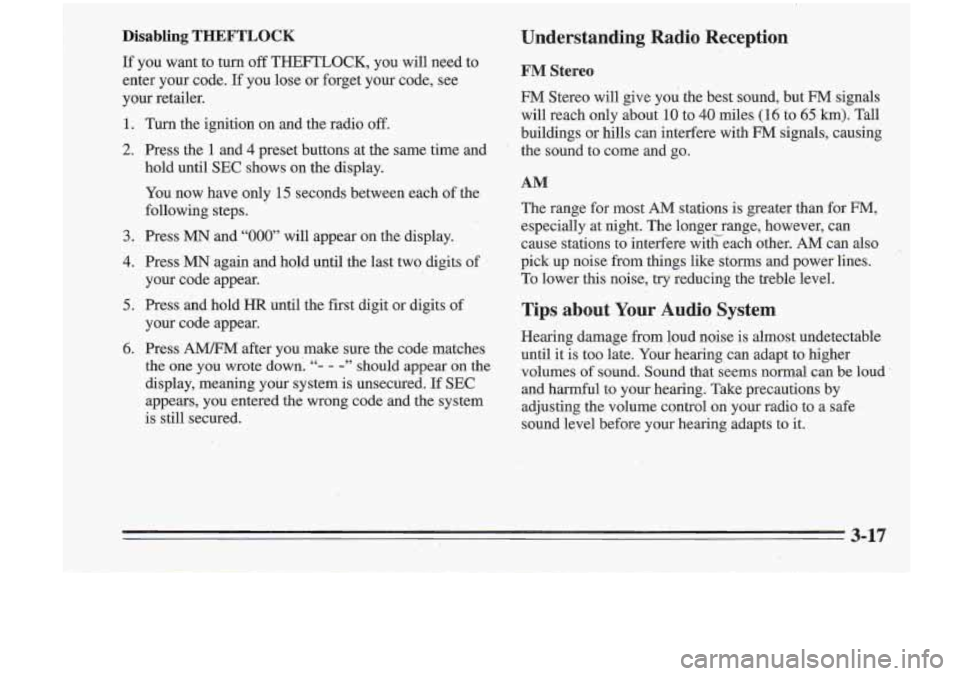
Disabling THEFTLOCK
If you want to turn off THEFTLOCK, you will need to
enter your code.
If you lose or forget your code, see
your retailer.
1. Turn the ignition on and the radio off.
2. Press the 1 and 4 preset buttons at the same time and
hold until
SEC shows on the display.
You now have only
15 seconds between each of the
following steps.
3. Press MN and “000” will appear on the display.
4. Press MN again and hold until the last two digits of
5. Press and hold HR until the first digit or digits of
your code
appear.
your code appear.
4. Press AM/FM after you make sure the code matches
!lie one you wrote down.
“- - -” should appear on the
display, meaning your system is unsecured.
If SEC
appears, you entered the wrong code and the system
is still secured.
Understanding Radio Reception
FM Stereo
EM Stereo will give you the best sound, but FM signals
will reach only about
10 to 40 miles (14 to 45 km). Tall
buildings or hills can interfere with
FM signals, causing
the sound to come and go.
AM
The range for most AM stations is greater than for F”,
especially at night. The longer range, however, can
cause stations to interfere withveach other.
AM can also
pick up noise from things like storms and power lines.
To lower this noise, try reducing the treble level.
Tips about Your Audio System
Hearing damage from loud noise is almost undetectable
until it is too late. Your hearing. can adapt to higher
volumes
of sound. Sound that seems normal can be loud
and harmful to your hearing. Take precautions by
adjusting the volume control on your radio to a safe sound level before your hearing adapts to it.
3-17
Page 149 of 340
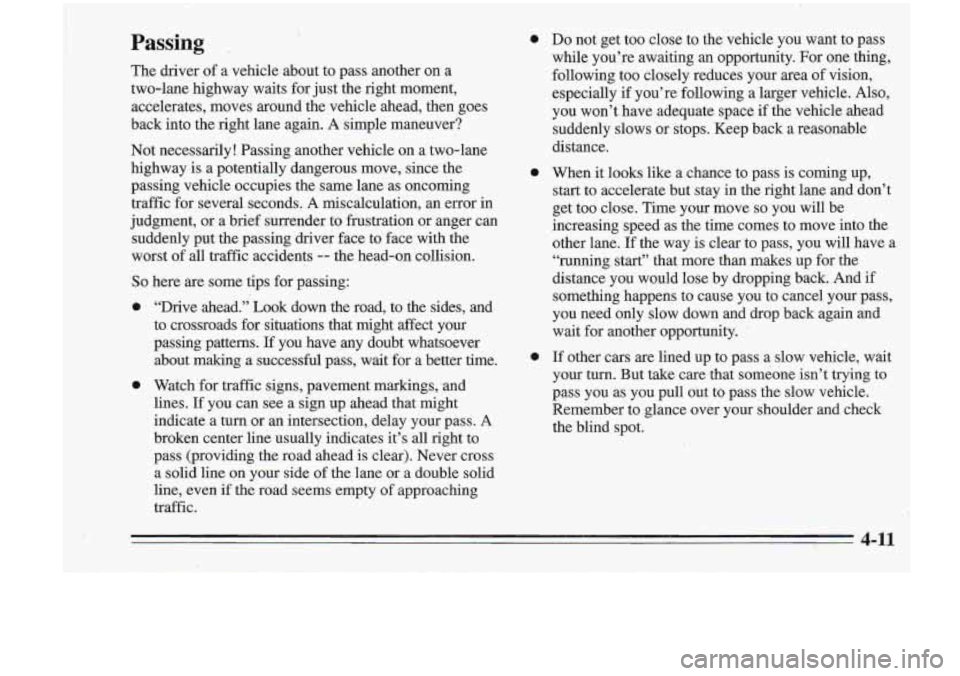
Passing
The driver of a vehicle about to pass another on a
two-lane highway waits for just the right moment,
accelerates, moves around the vehicle ahead, then goes
back into the right lane again. A simple maneuver?
Not necessarily! Passing another vehicle on a two-lane
highway is a potentially dangerous move, since the
passing vehicle occupies the same lane as oncoming
traffic for several seconds. A miscalculation, an error in
judgment, or a brief surrender to frustration or anger can
suddenly put the passing driver face to face with the
worst of all traffic accidents
-- the head-on collision.
So here are some tips for passing:
0 “Drive ahead.” Look down the road, to the sides, and
to crossroads for situations that might affect your
passing patterns.
If you have any doubt whatsoever
about making
a successful pass, wait for a better time.
0 Watch for traffic signs, pavement markings, .and
lines. If you can see a sign up ahead that might
~ indicate a turn or an intersection, delay your pass. A
broken center line usually indicates it’s
all right to
pass (providing the road ahead is clear).’Never cross
a solid line on your side
of the lane or a double solid
line, even
if the road st ns empty of approaching
traffic..
Do not .get too close to the vehicle you want to pass
while you’re awaiting an opportunity. For one thing,
following too closely reduces your area
of vision,
especially if you’re following a larger vehicle. Also,
you won’t have adequate space
if the vehicle ahead
suddenly slows or stops. Keep back a reasqnable
distance.
0
0
When it looks like a chance to pass is ,coming up,
start to accelerate but stay in the right lane and don’t
get too close. Time your move
so you will be
increasing speed- as the time comes to move into the
other lane. If the way is clear‘to pass, you will have a
“running start” that more than makes up for the
distance you would lose by dropping back
... And if
something happehs to cause you to cancel your pass,
you need only slow down and drop back again and
wait for another opportunity.
’
If other cars are lined up to pass a slow vehicle, wait
your turn. But take care that someone isn’t trying
to
pass you as you pull out to pass the slow vehicle.
Remember- to glance over your shoulder and check.
the blind spot.
, 4-11
Page 150 of 340
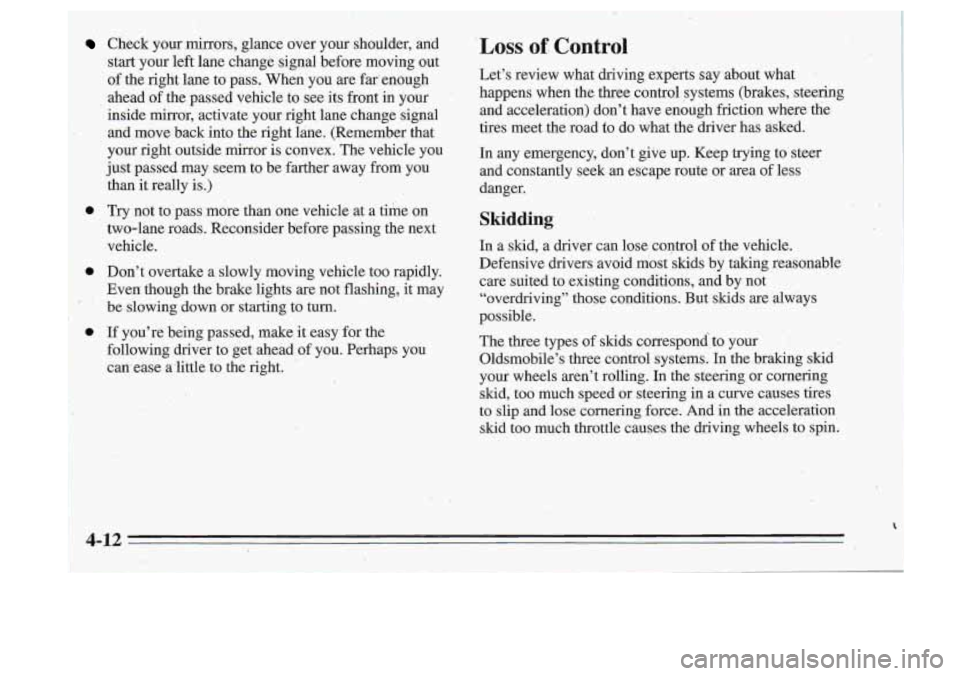
0
0
.. ..
Check your mirrors, glance over your shoklder, and
start your left lane change signal before moving out
of the right lane to pass. When you are far’enough
ahead of the passed vehicle to see its front in your
inside mirror, activate your right$ lane ,change signal
and move back into the right lane. (Remember that
your right outside mirror
is convex. The vehicle you
just passed may seem to be,farther away from
you
than it really is.)
Try not to pass more than one vehicle at a tihe on
two-lane roads. Reconsider before passing the next
vehicle.
Don’t overtake a slowly moving vehicle too rapidly.
Even though the brake lights are not flashing, it.may
be slowing down or starting tu turn.
If you’re being passed, make it easy for the
following driver to get ahead of you. Perhaps you
cmease a,little to the right.
.. : ‘ . .. ~
Loss of Control
Let’s review what driving experts say about what ’
happens when the three control systems (brakes, steering
and acceleration) don’t have enough friction where the
tires meet .the road
to do what ‘the driver has asked.
In any emergency, don’t give up. Keep trying to steer and constantly seek an es-c-gpe route or area
.~f less
danger.
Skidding
In a skid, a driver can lose control of the vehicle.
Defensive drivers avoid most skids by taking reasonable
care suited to existing conditions, and by not
“overdriving” those conditions. But skids are always
possibk.
The three types of skids correspondjo your
Oldsmobile’s three control systems. In the braking skid
your wheels aren’t rolling.
In the steering or cornering
skid, too much speed or steering in
a curve causes tires
to slip and lose cornering force. And in the acceleration
skid too much throttle causes the driving wheels to,spin.
, .*
I
4-12
Page 152 of 340
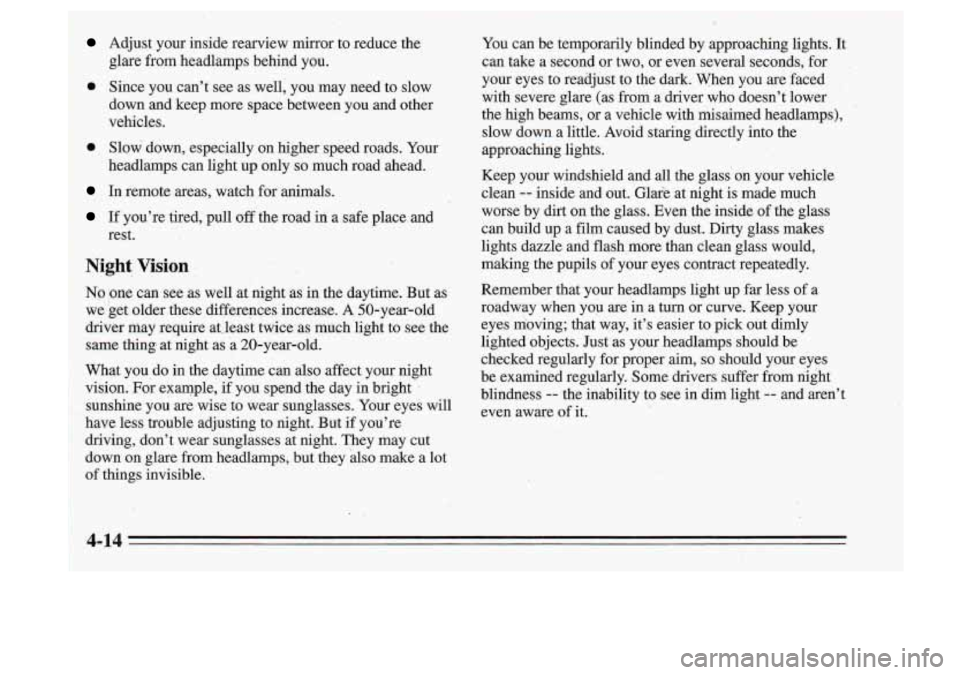
Adjust your inside rearview mirror to reduce the
. glare from headlamps behind you.
,e Since you can’t see as well, you may need to slow
down and keep more space between you .and other
. .. : vehicles.
Slow down, especially
on higher speed roads. Your
beadlpps can light up only
so much road ahead.
In remote areas, watch for animals.
If you’re tired, pull off the road in a safe place and
Night, Vision
No :one can see as well at night as in the daytime. But as
we get older these differences increase. A 50-year-old
driver may require at. least twice as much light to see the
same thing at night as a 20-year-old.
What you do
in the daytime can also affect your night
vision.
For example, if you spend the day in bright .
sunshine you are wise to wear sunglasses. Your eyes will
have less trouble adjusting to night.
Bat if you’re
driving, don’t wear sunglasses at night. They may cut
down on glare from headlamps, but they also make a lot
of things invisible. rest.
You
can be temporarily blinded by approaching lights. It
can take a second or two, or even several seconds, for
your eyes to readjust to the dark. When you are faced
with severe glare (as from a driver who doesn’t lower
the high beams, or a vehicle with misaimed headlamps), slow down a little. Avoid staring directly into the
approaching lights.
Keep your windshield and all
the glass on your vehicle
clean
-- inside and out. Glee at night is made much
worse by dirt on the glass. Even the inside of the glass
can build up a film caused by dust. Dirty glass makes
lights dazzle and flash more than clean glass would,
making the pupils
of your eyes contract repeatedly.
Remember that your headlamps light up far less of
a
roadway when you are in a turn or curve. Keep your
eyes moving; that way, ips easier to pick out dimly
lighted objects. Just as your headlamps should be checked regularly for proper aim,
SO should your eyes
be examined regularly. Some drivers suffer from night
blindness
3- the inability to see in dim light -- and aren’t
even aware of it.
4-14 .. .. .
Page 154 of 340

!
Driving too fast through large water puddles or even going through some car washes can cause problems, too.
The water may affect your brakes. Try to avoid puddles.
But if you can’t, try to slow down before you hit them.
Hydroplaning
Hydroplaning is dangerous. So much water can build up
under your tires that they can actually ride on the water.
This can happen if the road is wet enough and you’re
going fast enough. When your vehicle is hydroplaning,
it has little or no contact with the road. Hydroplaning doesn’t .happen often. But
it can if your
tires haven’t much tread or
if the pressure in one or
more
is low. It can happen if a lot, of water is standing on
the road. If you can see reflections froin trees, telephone
poles,
or other vehicles, and raindrops “dimple” the
water’s surface, there could be hydroplaning.
Hydroplaning usually happens at higher speeds. There
just isn’t a hard and fast
rule about hydroplaning. The
best advice
is to slow down when it is iaining.
Some Other Rainy weather Tips
1
0
0
0
,Turn on your low-beam headlights -- not just your
parking lights
-- to help make you ,more visible to
others.
Besides slowing down, allow some extra following distance. And be especially carefbl when you pass
another vehicle. Allow yourself more clear room
ahead, and, be prepared to have your view restricted
by road spray.
Have good tires with proper tread depth. (See “Tires” in the Index.)